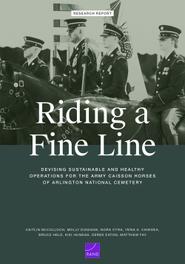Riding a Fine Line
Devising Sustainable and Healthy Operations for the Army Caisson Horses of Arlington National Cemetery
ResearchPublished Dec 9, 2024
In 2022, the deaths of two horses revealed issues within the U.S. Army Caisson Detachment, which conducts full honor funerals at Arlington National Cemetery. This report presents findings on the causes of these issues — including resource limitations, contrasting missions for the soldiers, and insufficient equine expertise in the unit — and guidance for developing a horse-first approach that will make the Army's caisson operations more sustainable.
Devising Sustainable and Healthy Operations for the Army Caisson Horses of Arlington National Cemetery
ResearchPublished Dec 9, 2024

In 2022, the deaths of two horses revealed issues within the U.S. Army Caisson Detachment, which conducts full honor funerals at Arlington National Cemetery. To understand the causes of these issues and develop recommendations for a better path forward, the authors conducted an extensive literature review, interviewed 70 equine experts and Army or government personnel, visited several domestic and international equine facilities, and performed six case studies of equine herds analogous to the Caisson Detachment's herd.
The authors' analysis revealed several findings related to the Caisson Detachment's doctrine, organization and leadership, personnel, training, materiel, and facilities, and the authors developed specific recommendations within these topics. Their findings included problems with resource limitations, a lack of sufficient equine expertise in the unit, and brief tenures and contrasting missions for the Caisson Detachment's soldiers. To address these and other issues, the authors recommend three paths forward for the Army: (1) Rethink Army maintenance of these historic operations, (2) modernize operations in line with recent equine science and best practices, and (3) improve day-to-day operations at the ground level. While each option will present unique costs and challenges for the Army, all three options are undergirded by a horse-first approach to the Army's caisson operations, which is essential to ensure a sustainable future for the Army caisson horses.
The research described in this report was sponsored by the U.S. Army for the Military District of Washington (USAMDW) and conducted by the Strategy, Doctrine, and Resources Program within the RAND Arroyo Center.
This publication is part of the RAND research report series. Research reports present research findings and objective analysis that address the challenges facing the public and private sectors. All RAND research reports undergo rigorous peer review to ensure high standards for research quality and objectivity.
This document and trademark(s) contained herein are protected by law. This representation of RAND intellectual property is provided for noncommercial use only. Unauthorized posting of this publication online is prohibited; linking directly to this product page is encouraged. Permission is required from RAND to reproduce, or reuse in another form, any of its research documents for commercial purposes. For information on reprint and reuse permissions, please visit www.rand.org/pubs/permissions.
RAND is a nonprofit institution that helps improve policy and decisionmaking through research and analysis. RAND's publications do not necessarily reflect the opinions of its research clients and sponsors.